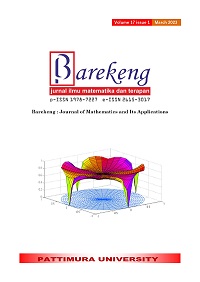BIFURCATION ANALYSIS MATHEMATICAL MODEL FOR THE SPREAD OF EXOGENOUS REINFECTION TUBERCULOSIS
Abstract
The spread of tuberculosis can occur in two ways, namely exogenous and endogenous. The spread of tuberculosis exogenously or Exogenous Reinfection of tuberculosis can be observed using a mathematical model. Then an analysis of the mathematical model with a bifurcation approach was carried out. Based on the result, it was found that there was a change in stability properties and the type of equilibrium point in the distribution equation system of exogenous reinfection tuberculosis, where the parameter that occurred bifurcation was , with . When value of is smaller than zero, the system of differential equations of exogenous reinfection tuberculosis shows an unstable with a saddle point type, when the value of is equal to zero the system of differential equations cannot be determined its stability, and when system of differential equations shows asymptotic stability, where there is a change in species. The points are nodes, star nodes, and spirals.
Downloads
References
Indrawati, F. Datau, P. Akuba, I. Anani, and J. Matematika, “Model Epidemik SIR Penyebaran Penyakit Tuberkulosis dengan Vaksinasi,” Pemodelan Mat. Univ. Gorontalo, pp. 318–330, 2020, doi: doi:10.31219/osf.io/x6j38.
CDC, “Core Curriculum on Tuberculosis : What the Clinician Should Know,” Centers Dis. Control Prev. Natl. Cent. HIV/AIDS, Viral Hepatitis, STD, TB Prev. Div. Tuberc. Elimin., 2021.
T. M. Daniel, “The history of tuberculosis,” Respir. Med., vol. 100, no. 11, pp. 1862–1870, Nov. 2006, doi: 10.1016/j.rmed.2006.08.006.
S. Khajanchi, D. K. Das, and T. K. Kar, “Dynamics of tuberculosis transmission with exogenous reinfections and endogenous reactivation,” Phys. A Stat. Mech. its Appl., vol. 497, 2018, doi: 10.1016/j.physa.2018.01.014.
C. Castillo-Chavez, “Dynamical models of tuberculosis and applications,” in CBMS-NSF Regional Conference Series in Applied Mathematics, 2013, vol. 1, no. 84, pp. 191–217, [Online]. Available: http://math.asu.edu/˜mbe/.
P. Narasimhan, J. Wood, C. R. Macintyre, and D. Mathai, “Risk factors for tuberculosis,” Pulmonary Medicine. 2013, doi: 10.1155/2013/828939.
J. Chakaya et al., “Global Tuberculosis Report 2020 – Reflections on the Global TB burden, treatment and prevention efforts,” Int. J. Infect. Dis., vol. 113, pp. S7–S12, Dec. 2021, doi: 10.1016/j.ijid.2021.02.107.
Widowati and Sutimin, “Bahan Ajar Pemodelan Matematika,” Univ. Diponegoro, 2007.
C. J. Kumalasari, “Eksistensi Bifurkasi Mundur Dan Kendali Optimal Pada Model Penyakit Vektor-Borne Yang Disebabkan Nyamuk,” Diss. Inst. Teknol. Sepuluh Nop., 2017.
G. Martin and D. Micheal, Linear algebra and differential equations using MATLAB. Books/Cole Publishing Company, 1999.
E. Rohaeti, S. Wardatun, and A. Andriyati, “Stability analysis model of spreading and controlling of tuberculosis,” Appl. Math. Sci., vol. 9, no. 49–52, pp. 2559–2566, 2015, doi: 10.12988/ams.2015.52100.
P. Sangapate, P. Tangjuang, and C. Somsila, “Stability Analysis and Adaptive Control of Spreading Tuberculosis Disease,” Int. J. Math. Comput. Sci., vol. 17, no. 1, pp. 231–242, 2022.
Z. Feng, C. Castillo-chavez, and A. F. Capurro, “A Model for Tuberculosis with Exogenous Reinfection,” vol. 247, pp. 235–247, 2000.
B. Singer and D. Kirschner, “Influence of backward bifurcation on interpretation of R_0 in a model of epidemic tuberculosis with reinfection,” Math. Biosci. Eng., vol. 1, no. 1, pp. 81–93, 2004, doi: 10.3934/mbe.2004.1.81.
T. K. K. Prasanta and K. Mondal, “Global Dynamics of a Tuberculosis Epidemic Model and the Influence of Backward Bifurcation,” pp. 433–459, 2012, doi: 10.1007/s10852-012-9210-8.
J. A. Caminero et al., “Exogenous Reinfection with Tuberculosis on a European Island with a Moderate Incidence of Disease,” 2001. [Online]. Available: www.atsjournals.org.
C.-Y. Chiang and L. W. Riley, “Exogenous re-infection in tuberculosis,” in Lancet Infectious Diseases, 2006, vol. 81, no. 2, pp. 79–91, doi: 10.1056/nejm199910143411609.
G. Shen et al., “Recurrent Tuberculosis and Exogenous Reinfection, Shanghai, China,” Emerg. Infect. Dis., vol. 12, no. 11, pp. 1776–1778, 2006, [Online]. Available: www.cdc.gov/eid.
T. Cohen, C. Colijn, B. Finklea, and M. Murray, “Exogenous re-infection and the dynamics of tuberculosis epidemics: Local effects in a network model of transmission,” J. R. Soc. Interface, vol. 4, no. 14, pp. 523–531, 2007, doi: 10.1098/rsif.2006.0193.
Copyright (c) 2023 Defri Ahmad, Sovia Helmi Putri, Rara Sandhy Winanda, Ariana Putri

This work is licensed under a Creative Commons Attribution-ShareAlike 4.0 International License.
Authors who publish with this Journal agree to the following terms:
- Author retain copyright and grant the journal right of first publication with the work simultaneously licensed under a creative commons attribution license that allow others to share the work within an acknowledgement of the work’s authorship and initial publication of this journal.
- Authors are able to enter into separate, additional contractual arrangement for the non-exclusive distribution of the journal’s published version of the work (e.g. acknowledgement of its initial publication in this journal).
- Authors are permitted and encouraged to post their work online (e.g. in institutional repositories or on their websites) prior to and during the submission process, as it can lead to productive exchanges, as well as earlier and greater citation of published works.






1.gif)



